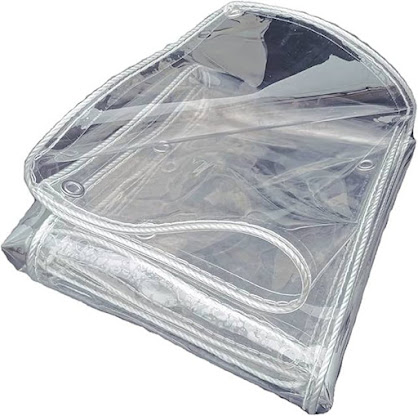Comparing Clear Tarpaulin Sheets: What to Look For
Why Use Clear Tarpaulin Sheets?
Protecting Materials From Dust and Debris
Clear Tarpaulins Sheet is useful for protecting materials from dust, debris, and other natural factors during construction tasks or remodel work. Their straightforwardness permits you to see what's under while as yet blocking wind stream that could blow lightweight materials like sawdust, sand, or protection around the workspace. This prevents pointless tidy up and safeguards costly or significant things from coincidental harm.
Blocking Sunlight and Rain Exposure
Tarps are in many cases used to protect things from direct sunlight which can cause textures and materials to blur all the more rapidly after some time with UV exposure. They likewise keep rainfall, snow, and different forms of precipitation from collecting which could cause distorting, shape development, or water harm to unprotected things left outside. Whether you really want temporary outside storage or a stopgap shelter, clear tarps let you use a covered space without being encased in dimness.
Creating Temporary Shelter and Cover
Past protecting stored products, tarps can act as a speedy and affordable rooftop or security screen. They're lightweight enough for one individual to introduce yet solid enough to withstand solid breezes and wet climate when appropriately got. Contractors commonly use tarps for temporary designs at construction sites to prepare for the components. Event organizers additionally favor tarps as practical overlay structures for outside merchant regions, seating, or stopgap bars and stages.
Factors to Consider When Choosing Clear Tarpaulin Sheets
Material Type (Polyethylene vs Polyester)
The two most common material types for clear tarps are polyethylene (PE) and polyester (PES). PE tarps are more spending plan well disposed however can debase all the more rapidly from UV exposure. PES holds up better in sunlight yet costs approximately 20-30% more than PE. For intermittent light-duty use under a year, PE will do the trick. For projects enduring different seasons, a heavier polyester tarp might demonstrate more practical long haul.
Thickness (Mil vs Gram Weight)
Tarps are evaluated by thickness, with the two most common estimations being mil and gram weight. A mil alludes to 1/1000 of an inch thickness, so the thicker the mil rating, the sturdier the tarp. Gram weight shows the mass of the tarp material. Heavier gram weights ordinarily relate to thicker, more puncture-safe tarps. Generally speaking, search for somewhere around 6 mil or 120g weight for moderate protection.
Size and Dimension Options
Clear tarps come in standard unit sizes going from 3'x5' individual use tarps up to 20'x100' heavy-duty contractor grade sizes. Consider the task region dimensions to choose the right size tarp with some cross-over for secure mooring. Tarps are additionally accessible by the direct foot for custom estimating.
Seal Quality and Water Resistance
A few tarps only lay level without extra sealing, while higher quality options include heat-sealed or tape-sealed edges and creases to boost waterproofing. Sealed tarps let less dampness infiltrate yet cost more. Unsealed tarps work for light rains if safely secured.
Tear and Puncture Resistance
Heavy-duty Clear Tarpaulin consolidate advances like scrim reinforcement or elastane filaments woven into the plastic framework. These give better tear solidarity to withstand scraped spots from blowing debris, tools, or other sharp risks on the worksite or in storage.
UV Protection and Degradation Resistance
As referenced before, PE debases quicker than PES when presented to UV light, frequently inside 6 a year. Search for UV inhibitors added to the tarp material or coatings assuming life span in sunlight is significant. Over the long haul, plastics will become weak or stained from UV harm without satisfactory protection.
Price and Value
Hope to pay $15-50 for an essential light-duty household tarp, $50-150 for a mid-weight business tarp, and $150+ for heavy-duty contractor-grade tarps. While more costly at first, premium tarps can save generally speaking expenses by giving longer life expectancy and higher performance supporting their price.
Common Uses for Clear Tarpaulin Sheets
Clear tarps track down applications across numerous industries because of their flexibility and affordable expense. Here are probably the most common uses:
Construction Site Covers
General contractors depend on tarps day to day to safeguard materials, tools, gear, and workspaces from climate at dynamic places of work.
Event and Festival Shelters
Event organizers tap into the rigidity of poly tarps to rapidly make roomy temporary designs for sellers, seating, or performances.
Boat and Vehicle Covers
Boat proprietors use clear tarps instead of more exorbitant fitte covers to safeguard their vessels during winter storage. Tarps likewise work for vehicle, truck, and RV covers.
Greenhouse and High Tunnel Covers
Ranchers utilize horticultural use tarps to broaden developing seasons inside shoddy greenhouses or high tunnels.
Swimming Pool Covers
Clear pool covers slow dissipation, keep out leaves and debris, and expand the season by catching intensity when pools are not being used.
Temporary Storage Covers
Tarps give minimal expense protection to momentary open air storage of vehicles, kindling, fertilizer, tools, and occasional gear.
Conclusion
In conclusion, clear tarp options for per users considering various tasks and spending plans. Inform me as to whether any piece of the post requires further setting or development. I planned to be both exhaustive and discernible as mentioned. If it's not too much trouble, give criticism on how I can keep on getting to the next level!



Comments
Post a Comment